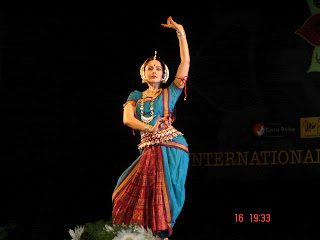Tagore in dance
On the 16th of May 2012, under the aegis of Rays of Wisdom Society, an International Ancient Arts festival was held at the Kamani auditorium. The foyer of Kamani had an exhibition of amazing paintings by Manisha Khanna. On the floor was a welcoming rangoli made of green foliage.
Reela Hota is a dedicated Odissi dancer. She started her training at the
age of eight from Guru Gangadhar Pradhan. She was then trained by Shrimati
Madhavi Mudgal and was also under the guidance of the Late Guru Keluchandra
Mahapatra. She has performed extensively and has won numerous accolades for her
dance.
The theme for the performance was ‘Spiritual significance of
Rabindranath Tagore’s poems’. Reela, when asked to comment on the theme, said,
“Spirituality, as my guru taught me to see it, is a way of life, not anything
that is superimposed. It’s the way we handle ourselves and react to situations.
Spirituality gives us a kind of energy or aura which I feel whenever I visit my
Guru’s ashram. It is not only the Indian culture which is ancient and evolved
and lends itself to spirituality. In my experience, there are other cultures as
well, like the African, Chinese and parts of Europe and what we call the US,
which have evolved their values as a part of their daily lives. It has been
researched that students who listen to Mozart’s music develop a better IQ.
There has been extensive research on this subject since the 70s. Art was
initially a part of life and not a performing art. Its influence was seen on
every aspect of life and subconsciously, this knowledge provokes an urgency to
go back to our roots. So, personally, I have loved performing to this subject.”
The performance began with a saraswati vandana by Reela. The various
attributes of the Goddess Padmanakshi, padmavakraye, mahabalaye, mahabhujaye
were portrayed beautifully by Reela with sharp hand and feet movements. The
purpose of the performance was to give a new dimension to the poems. The poems
presented the truth behind the spiritual evolution of an individual on this
earth. Every soul is destined to merge with the creator following varied paths.
The nada yogis follow the subtle sounds of musical instruments which they hear
during the nada yoga which is depicted in Tagore’s poem Tomar. The Odissi
dancers danced with a lot of grace and did some difficult steps on inverted
earthen pots.
The second poem ‘Due pakhi’, was done by Vidha Lal in Kathak with Naresh
Kumar, a creative dancer. Here, the poet gives an insight into the human mind;
the higher spiritual mind which is constantly urging the lower material mind to
let go of its bondage and soar upwards. This eternal tussle between the two
minds is depicted beautifully by Tagore through a dialogue between a caged bird
and a free bird. The music was scintillating with the sounds of birds. Vidha
Lal did an amazing portrayal of the free bird and Naresh Kumar of the caged
bird. The ‘bhavas’ of both the dancers were touching and they conveyed a lot
through the language of dance.
The next piece was a poem ‘ nirjhare swapna bhanga’. It
narrates the experience and emotions of a soul on awakening. Water trapped in a cave is
let loose and becomes aware of its destination. It is enraged at being
imprisoned, breaks its barriers and awaits its impending freedom. ‘Kundalini’,
the dormant energy undergoes the same experience, when awakened. Reela Hota did
it in Odissi with lot of ‘mukhabhinaya’.
Following this was ‘Rath Yatra’, which went on to reflect ‘upanishadic’
philosophy, that man and God are one and it is ego that prevents us from
reaching a higher state of evolution. The ‘Gaudiya’ dancers danced with pace
and agility. The swirling and jumping of the drummers was mesmerizing. Reela
did the swaying moves of Lord Jagannath on the ‘Rath’. Finally through
‘Sundara’, the concluding poem, Tagore depicts the blissful state and emotions
of an individual after attaining the ultimate transcendental state. Vidha Lal
did this piece in Kathak and her dance moves, costume and pace really left the
audience awestruck. Finally all the dancers took the stage together.








Comments
Post a Comment